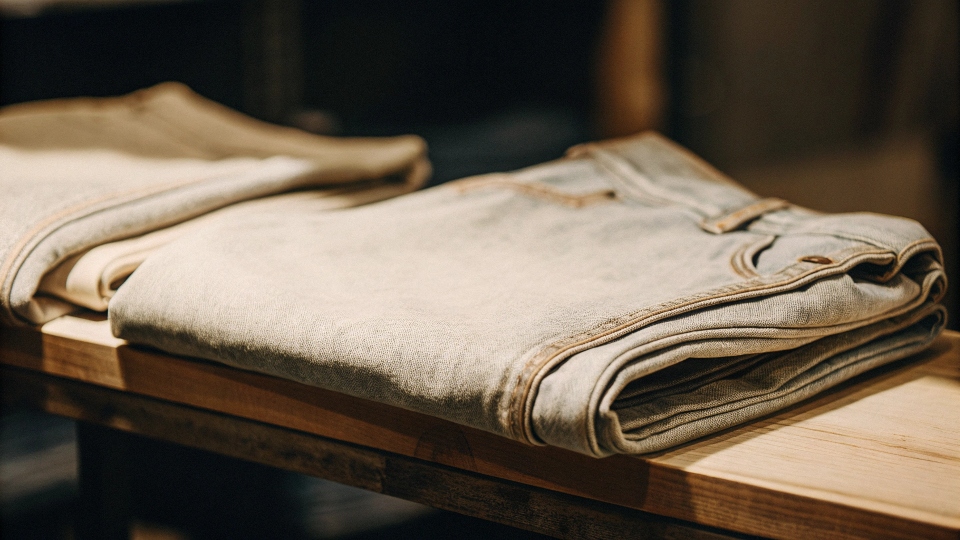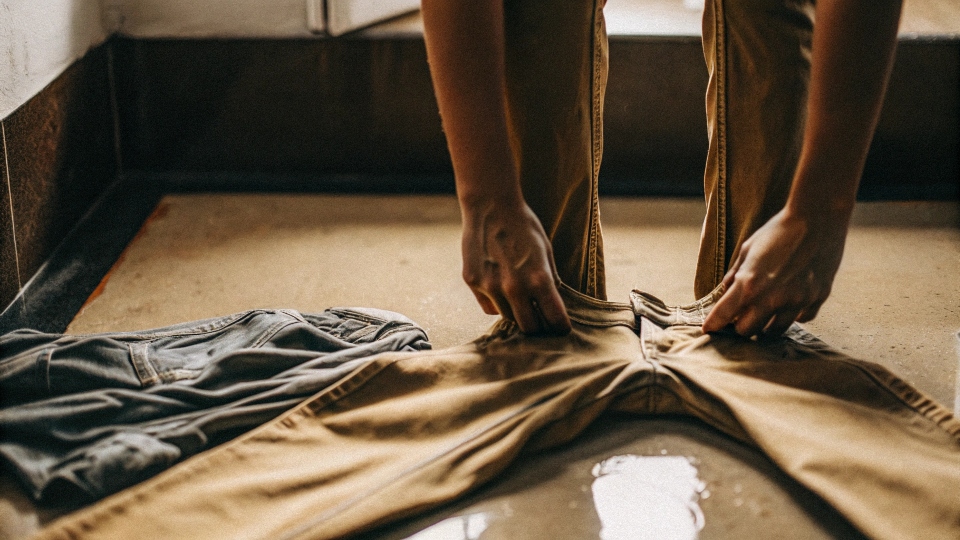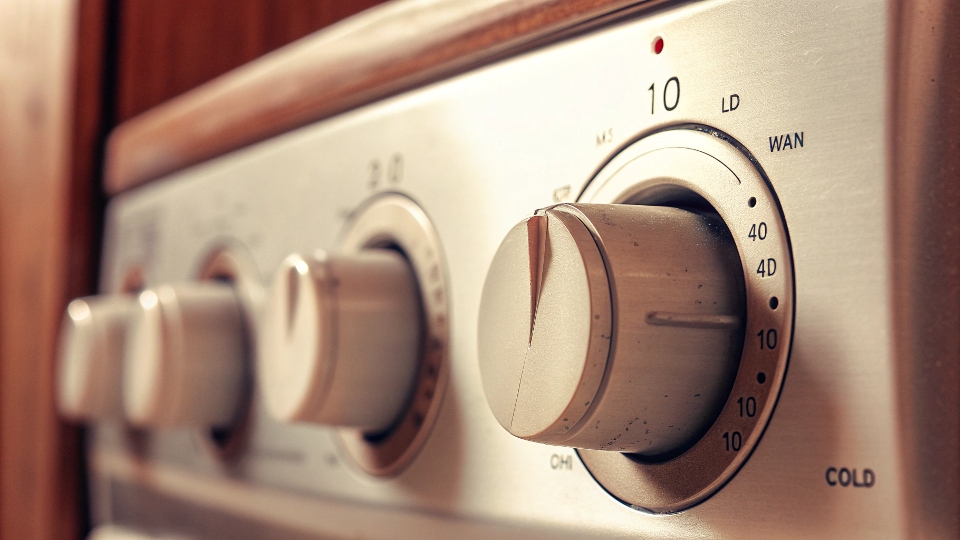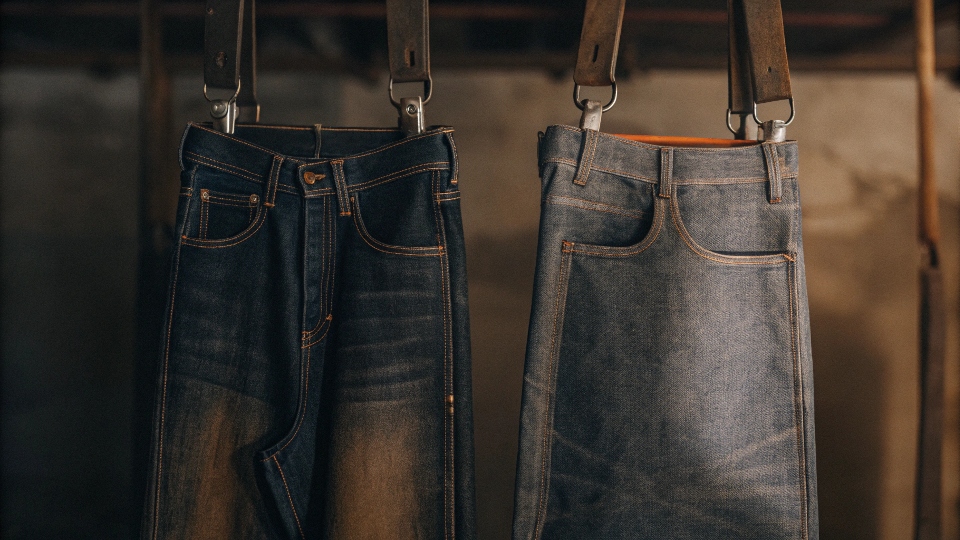You pulled your favorite jeans from the wash, but they feel like cardboard. That comfortable, broken-in feel is gone, replaced by a rigid fabric that's no fun to wear.
To make jeans less stiff, avoid high-heat drying. The best method is to air-dry1 them until they are just damp, then tumble dry2 on a low or no-heat setting with dryer balls to relax the cotton fibers.
I've been working with denim for over 20 years at my factory, DiZNEW. I can tell you that the single biggest mistake people make happens right in their laundry room.
The stiffness you feel isn't a flaw in the jeans; it's a reaction of the cotton fibers to the washing and, especially, the drying process. Designers like Dean put so much thought into the feel of a garment, and it's a shame to see that ruined by a simple laundry error.
The good news is that it's completely reversible. It's not about complicated chemicals, but about understanding how to treat the fabric gently. Let me show you the simple techniques to keep your jeans feeling perfect.
How do you soften jeans after washing?
Your freshly washed jeans are stiff and immobile. You miss the soft, flexible texture they had before, and they just don't feel right against your skin. This is a common problem.
For a quick fix, run your jeans through a rinse cycle using one cup of white vinegar instead of fabric softener. The vinegar will strip away stiff detergent residue3 and naturally relax the fibers without harsh chemicals.
In the factory, we test different softening methods all the time. Your insight about using fabric softener4 is very popular, and it works because it coats the fibers in a waxy lubricant.
However, this coating can build up over time, reduce the fabric's ability to breathe, and even damage the elastane that gives stretch jeans their recovery. A better, cheaper, and safer method is using simple white vinegar. It breaks down any leftover detergent that causes stiffness and softens the water.
Don't worry about the smell; it disappears completely once the jeans are dry. For an even more powerful effect, combine the vinegar rinse with a physical softener.
Tossing two or three wool dryer balls into the dryer with the damp jeans physically beats the fabric, breaking up the stiffness and separating the fibers. This combination of a clean rinse and a gentle tumble is the best way to restore that perfect, soft feel.
| Softening Method | Pros | Cons |
|---|---|---|
| Fabric Softener | Adds scent, very effective | Coats fibers, can damage stretch |
| White Vinegar | Removes residue, natural, cheap | Initial smell (dissipates quickly) |
| Dryer Balls | Reusable, eco-friendly, speeds drying | Can be a bit noisy in the dryer |
How to fix tight jeans after washing?
You can barely button your jeans after pulling them from the dryer. That perfect fit is gone, and they feel a full size too small. It's a frustrating moment for anyone who loves their denim.
To fix jeans that have become too tight, work with them while they are still damp. Lay them on the floor and gently but firmly pull on the waistband and legs to stretch the fibers back into shape.
This is a classic issue, especially with 100% cotton jeans. The heat and water cause the cotton fibers to contract and tighten. The trick is to stretch them back out before they fully dry and "lock" in that smaller size.
The method is simple. While the jeans are still damp, lay them flat. Step on one side of the waistband with your foot to anchor it, then grab the other side with both hands and give it a few firm, steady pulls. You will feel the fabric give.
Do this a few times, then repeat the process for the thighs and the length of the legs. An even more effective method, one I use for new raw denim samples, is to wear the damp jeans.
Put them on when they are just a little tight and wear them around the house for 15-20 minutes. Your body provides the perfect form, and as they dry, they will mold to your exact shape, creating a custom fit.
How to wash jeans so they're not stiff?
You hesitate to wash your perfectly broken-in jeans. You know that once they go through the laundry, they'll lose their softness and come out feeling like a board. This cycle is annoying.
To prevent stiffness, always wash your jeans inside out in cold water5 on a gentle cycle. Use about half the recommended amount of a mild liquid detergent and never use high heat in the dryer.
Preventing stiffness is all about creating a gentler laundry routine. The harshness of a standard wash cycle is what causes the problem. Here are the exact steps we advise our brand partners to share with their customers.
Step 1: Use Cold Water and Less Soap
Heat is the enemy. It causes fibers to seize up. Cold water cleans perfectly well and protects the fabric and color. Also, most people use far too much detergent. The excess doesn't rinse out properly and leaves behind a stiff residue. Cut your detergent use in half, and always choose a mild liquid over a powder.
Step 2: Wash Inside Out on a Gentle Cycle
Turning your jeans inside out protects the outer surface, which is the part you feel. It reduces the friction that can rough up the texture of the denim. A gentle or delicate cycle is less aggressive and tumbles the clothes slowly, which is much kinder to the fabric.
Step 3: Avoid High-Heat Drying
This is the most critical step. High heat is what bakes the fibers into a rigid state. The absolute best method is to hang your jeans to air dry until they are about 90% dry. Then, toss them in the dryer on a low or no-heat setting for 10 minutes with dryer balls to soften them up. This gives you the best of both worlds: no shrinkage and a soft finish.
How to make jeans stiff again?
Your raw denim has become too soft and comfortable over time. It has lost the structured, crisp feel you loved, and you want to bring back that original rigidity to create sharper fades.
To make jeans stiff again, give them a starch bath. Dissolve a few tablespoons of cornstarch in cold water, let the jeans soak for an hour, and then hang them to dry without rinsing.
This might sound strange to some, but in the world of denim enthusiasts, restoring stiffness is a common goal. For raw denim6, a rigid fabric creates sharper creases at the points of wear, like the lap (whiskers) and behind the knees (honeycombs).
These sharp creases lead to better, high-contrast fading over time. It's a technique used by denim heads to reset their "fade project." The process is very simple and uses a cheap ingredient from your kitchen: cornstarch.
You just need to mix a few tablespoons into a bucket of cold water until it fully dissolves. Submerge your jeans, making sure they are soaked through, and let them sit for about an hour.
Then, gently squeeze out the excess water—don't wring them—and hang them up to air dry. As they dry, the starch will bond to the cotton fibers, making the jeans incredibly stiff and ready to create beautiful new wear patterns.
Conclusion
Controlling the feel of your jeans is simple. Use less heat, less detergent, and a dash of vinegar to soften them. To restore stiffness to raw denim, a simple cornstarch soak will do the trick.
-
Learn the best practices for air-drying jeans to keep them soft and comfortable after washing. ↩
-
Discover effective tumble drying techniques that prevent stiffness and maintain the quality of your jeans. ↩
-
Understanding detergent residue can help you avoid stiffness and keep your jeans feeling great. ↩
-
Learn about the pros and cons of using fabric softener on jeans to make informed laundry choices. ↩
-
Understand the advantages of washing jeans in cold water to preserve their quality and color. ↩
-
Explore the unique characteristics of raw denim and how to maintain its structure and style. ↩










